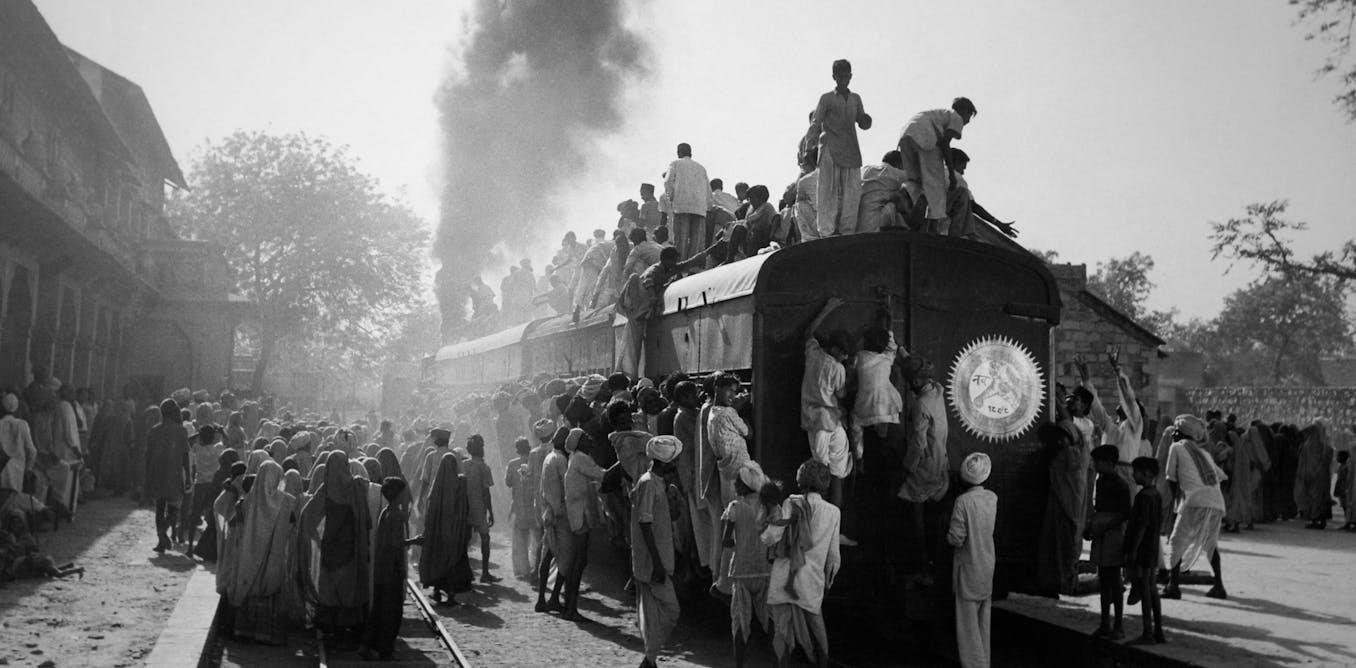Overcrowded trains serve as metaphor for India in Western eyes – but they are a relic of colonialism and capitalism


A devastating rail crash that left almost 300 people dead has refocused international attention on the importance of railways in the lives of Indians.
Indeed, to many Western observers, images of men and women crammed into overcrowded cars serve as a metaphor for modern India.
Take, for example, a report by German newspaper Der Spiegel on India’s population surpassing China’s. Published just weeks before the accident in Odisha province on June 2, the now much-criticized cartoon depicted a shabby Indian train crammed with passengers rushing past a streamlined Chinese train with only two people in it.
Where does this enduring image in the West of Indian railways – and of India – come from?
As a scholar of Indian history and author of 2015 book “Tracks of Change: Railways and Everyday Life in Colonial India,” I believe the answers lie in the gigantic infrastructure projects of the 19th century – forged at the intersection of colonial dictates and capitalist demands.
A carrier of freight, not people
Railways remain the backbone of passenger traffic in India, transporting some 23 million people daily. In the pre-pandemic 2018-19 financial year, 7.7 billion passenger journeys in India. In comparison, even after a dramatic post-pandemic increase, airline passenger traffic was 123.2 million in 2022.
 People board an overcrowded train at a railway station on the outskirts of New Delhi, India. Kabir Jhangiani/NurPhoto via Getty Images
People board an overcrowded train at a railway station on the outskirts of New Delhi, India. Kabir Jhangiani/NurPhoto via Getty Images
Yet, when first planned in the 1840s, India’s railways were intended to primarily transport freight and livestock, not people.
Indians were thought unlikely to become railway passengers by directors of the English East India Co., a merchant monopoly that gradually annexed and administered large parts of India under U.K. crown control.
Many people at the time disagreed that Indians were immobile people, however, pointing out that the country had a long history of global trade across vast oceanic networks.
However, early colonial railway policy was driven by pervasive Orientalist imaginings of a people rendered immobile by poverty, living in isolated villages and constrained by religious restrictions prohibiting travel.
The trope interlocked with colonial thinking that railways would foster greater industrialization which in turn would further a capitalist economy.
 Vande Bharat Express train as seen in Kolkata, India. Debarchan Chatterjee/NurPhoto via Getty Images
Vande Bharat Express train as seen in Kolkata, India. Debarchan Chatterjee/NurPhoto via Getty Images
They also aligned with the practical needs of a colonial trading monopoly which needed raw materials for English industries, such as cotton, to be moved swiftly and efficiently from India’s interiors to port towns, from where they could be shipped.
Relegated to cheap seats
To induce the “natives,” as the British often referred to their colonial subjects, to use railways, the colonial government pitched low fares, especially in third-class cars – the lowest and cheapest category of rail travel.
The decision to introduce lower fares seems at odds with the profit-driven aims of a capitalist venture, with money raised by private companies incorporated in the United Kingdom.
However, British capitalists and shareholders in these private ventures did not have to fear for their profits, which were underwritten by the Indian taxpayer. The colonial government of India guaranteed these companies a 5% annual return on their investment whether or not the venture turned a profit.
Despite the doubters, the new Indian railways attracted an increasing number of passengers.
The half-million passengers recorded in 1854 when tracks became operational increased to 26 million in 1875. By 1900, annual passenger figures stood at 175 million and then almost trebled to 520 million by 1919-20. By the time of the partition of India in 1947 it had risen to more than 1 billion passenger journeys annually. Indeed, images of overcrowded trains came to epitomize the upheaval of partition, with the rail system used to carry swaths of uprooted peoples across the soon-to-be Pakistan-India border.
Third-class passengers, overwhelmingly Indians, comprised almost 90% of this traffic.
These escalating figures did not, however, generate a lowering of fares. Nor did they result in any substantial improvements in the conditions of overcrowded, unsanitary third-class travel.
Instead, railway companies sought “the greatest economy of space and load,” as one rail manager put it. Inadequate rolling stock, much of it imported, exacerbated matters.
A tool for ‘self-composure’
The generally British railway managers seemed disinclined to remedy systematic overcrowding, which included transporting passengers in wagons meant for livestock. Rather, they insisted that such overcrowding was caused by the peculiar habits and inclinations of Indian passengers: their alleged abhorrence of empty carriages and their inclination to follow one another “like sheep” into crowded carriages.
These attributes were soon rendered into a more public narrative, especially among Western mindsets. Journalist H. Sutherland Stark, writing for the industry publication Indian State Railways Magazine in 1929, stated that though “unversed” in railway administration and traffic control, he knew railway facilities were not the problem. Rather, Indian passengers lacked the mental preparedness, “self-possession” and “method” necessary to travel like “sane human beings.”
Stark suggested passenger education as a solution to the perceived problem, making railway travel a tool for “self-composure and mass orderliness.” He was not the only one to suggest a congruence between rational railway travel and reasonable public behavior. In the 1910s, though condemning railway management for perpetuating the indignities that third-class passengers faced, the nationalist leader Mahatma Gandhi also suggested educating railway passengers as a means to create a civic body of citizens.
A continuing metaphor
More than a century later, this depiction endures, though, ironically, it now serves as a foil to understanding contemporary India. In a piece published in The New York Times on March 12, 2005, the author lauded the then-new Delhi metro, emphasizing that it had “none of the chaotic squalor of hawkers and beggars that characterizes mainline railroads in India, nor do desperate travelers hang from the sides of the trains.”
As the debate rages on whether safety has taken a back seat to “glossy modernization projects” in India – early analyses suggest signaling failure might have caused June 2, 2023, accident – railways continue to represent India’s history.
In the heyday of empire, they were deemed the technology through which Britain would drag India into capitalist modernity. In 1947, they became a leitmotif for the trauma of the partition that accompanied the independence of India and Pakistan. As the coverage of Odisha accident reminds us, it continues to be a metaphor in the West for evaluating contemporary India.





